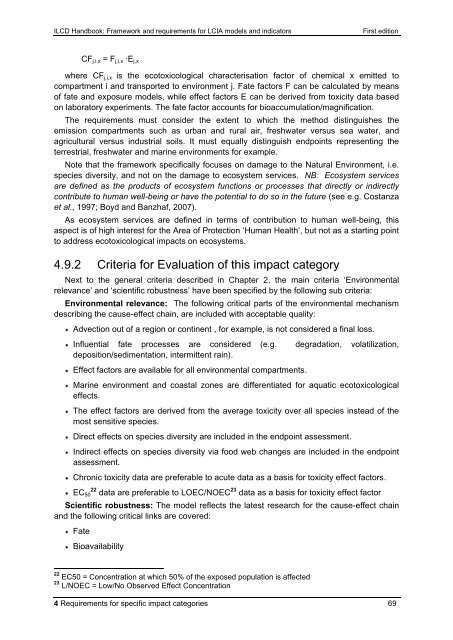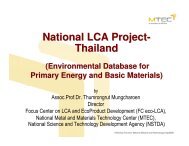ILCD Handbook: Framework and requirements for LCIA models and ...
ILCD Handbook: Framework and requirements for LCIA models and ...
ILCD Handbook: Framework and requirements for LCIA models and ...
You also want an ePaper? Increase the reach of your titles
YUMPU automatically turns print PDFs into web optimized ePapers that Google loves.
<strong>ILCD</strong> <strong>H<strong>and</strong>book</strong>: <strong>Framework</strong> <strong>and</strong> <strong>requirements</strong> <strong>for</strong> <strong>LCIA</strong> <strong>models</strong> <strong>and</strong> indicators First edition<br />
CFj,i,x = Fj,i,x ·Ej,x<br />
where CFj,i,x is the ecotoxicological characterisation factor of chemical x emitted to<br />
compartment i <strong>and</strong> transported to environment j. Fate factors F can be calculated by means<br />
of fate <strong>and</strong> exposure <strong>models</strong>, while effect factors E can be derived from toxicity data based<br />
on laboratory experiments. The fate factor accounts <strong>for</strong> bioaccumulation/magnification.<br />
The <strong>requirements</strong> must consider the extent to which the method distinguishes the<br />
emission compartments such as urban <strong>and</strong> rural air, freshwater versus sea water, <strong>and</strong><br />
agricultural versus industrial soils. It must equally distinguish endpoints representing the<br />
terrestrial, freshwater <strong>and</strong> marine environments <strong>for</strong> example.<br />
Note that the framework specifically focuses on damage to the Natural Environment, i.e.<br />
species diversity, <strong>and</strong> not on the damage to ecosystem services. NB: Ecosystem services<br />
are defined as the products of ecosystem functions or processes that directly or indirectly<br />
contribute to human well-being or have the potential to do so in the future (see e.g. Costanza<br />
et al., 1997; Boyd <strong>and</strong> Banzhaf, 2007).<br />
As ecosystem services are defined in terms of contribution to human well-being, this<br />
aspect is of high interest <strong>for</strong> the Area of Protection ‗Human Health‘, but not as a starting point<br />
to address ecotoxicological impacts on ecosystems.<br />
4.9.2 Criteria <strong>for</strong> Evaluation of this impact category<br />
Next to the general criteria described in Chapter 2, the main criteria ‗Environmental<br />
relevance‘ <strong>and</strong> ‗scientific robustness‘ have been specified by the following sub criteria:<br />
Environmental relevance: The following critical parts of the environmental mechanism<br />
describing the cause-effect chain, are included with acceptable quality:<br />
Advection out of a region or continent , <strong>for</strong> example, is not considered a final loss.<br />
Influential fate processes are considered (e.g. degradation, volatilization,<br />
deposition/sedimentation, intermittent rain).<br />
Effect factors are available <strong>for</strong> all environmental compartments.<br />
Marine environment <strong>and</strong> coastal zones are differentiated <strong>for</strong> aquatic ecotoxicological<br />
effects.<br />
The effect factors are derived from the average toxicity over all species instead of the<br />
most sensitive species.<br />
Direct effects on species diversity are included in the endpoint assessment.<br />
Indirect effects on species diversity via food web changes are included in the endpoint<br />
assessment.<br />
Chronic toxicity data are preferable to acute data as a basis <strong>for</strong> toxicity effect factors.<br />
EC50 22 data are preferable to LOEC/NOEC 23 data as a basis <strong>for</strong> toxicity effect factor<br />
Scientific robustness: The model reflects the latest research <strong>for</strong> the cause-effect chain<br />
<strong>and</strong> the following critical links are covered:<br />
Fate<br />
Bioavailability<br />
22 EC50 = Concentration at which 50% of the exposed population is affected<br />
23 L/NOEC = Low/No Observed Effect Concentration<br />
4 Requirements <strong>for</strong> specific impact categories 69



